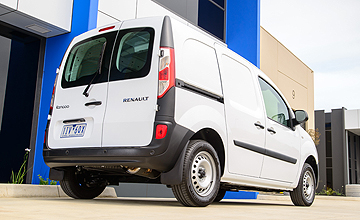BY ROBBIE WALLIS | 24th Feb 2017

The new powerplant comes with a $1500 price hike but a number of positive changes, including increased output, reduced fuel consumption and better cruising speeds – all important features for a workhorse commercial van.
The six-speed manual borrowed from the previous-generation Clio RS kicks off proceedings from $23,490 plus on-roads, while the six-speed dual-clutch automatic, also the only auto in the Kangoo range until the arrival of the diesel auto in July, costs $26,490.
For comparison, the Citroen Berlingo range starts from $21,990 for the turbo-petrol manual, while the Volkswagen Caddy – the best-selling model in the segment – kicks off with the manual TSI220 Maxi Van variant from $28,590.
The new all-aluminium engine in the Kangoo makes 84kW at 4500rpm and 190Nm between 2000-4000rpm, a 6kW increase in power, and crucially, a 42Nm increase in torque.
Once behind the wheel, the change from a four-speed automatic to a six-speed dual-clutch auto is most obvious when driving on the freeway at 110km/h, where the tachometer sits at a comfortable 2450prm – a 30 per cent reduction over the old model according to Renault.
At 100km/h that number drops to 2000rpm, however it should be noted that the Kangoo we drove was unladen, and one with a full cargo space would be expected to work harder.
Overtaking at freeway speeds has to be done with care, as the little engine runs out of puff at speeds in excess of 110km/h.
On the freeway the engine is whisper quiet, with some tyre and wind noise the only detractors in what was an otherwise quiet cabin by LCV standards.
The ride is also remarkably settled for a delivery van, with the Kangoo soaking up bumps and rattles in the road without the bounce and thumps expected from an unladen van.
Renault said steps had been taken to reduce noise, vibration and harshness (NVH) levels in the updated Kangoo, and it is apparent when driving it.
Going through the gears the automatic transmission is smooth and user-friendly, shifting intuitively and keeping the engine revs relatively low at any speed.
The six-speed Clio RS-derived manual is a less user-friendly proposition, but it’s nothing to do with the box itself.
For taller drivers the lack of reach adjustment for the steering wheel could be a problem. For those who have to adjust the seat back to accommodate for longer legs, the wheel became nearly unreachable, to the point where finding a comfortable driving position was difficult. Shorter folk won’t find it a problem.
Pushing the seat closer to the wheel makes the clutch difficult to operate, as it has a very high bite point and drawing the clutch out requires moving your whole leg.
After taking a bit of getting used to, the manual is easy enough to use with a light clutch, and shift indicator that encourages you to stay within the sweet spot in the rev range.
There isn’t as much room for error when taking off at low speeds in second gear as there is in torquier diesel engines, and when carrying a load around town first gear would need to be used liberally.
Clutch fiddles aside, the cabin is comfortable and airy, with ample legroom for the passenger, an agreeable seating position that allows for good visibility and comfort, and plenty of storage points for the bits and pieces that can be found in a work van.
There is a large cavity above the dashboard for folders and sheets of paper, while both driver and passenger sun visors have two slots to stick notes and invoices into.
There are two shallow cupholders that would probably struggle to hold any drink taller than a can, but the two-part door bins had space for bottles.
Extra storage includes two gloveboxes and a deep centre console that reached almost to the elbow when putting your hand inside.
As is the case for most LCVs the dashboard is a utilitarian, form-over-function affair with a small media/radio player, and air-con unit taking up most of the room. The optional 7.0-inch sat-nav touchscreen was absent.
The entertainment unit does feature Bluetooth, AUX and USB capability, as well as a CD player and FM/AM radio, while a 12V port is located in the centre console.
The three cubic metre cargo area is typically bare-bones with exposed metal panels and a cargo floor mat, as well as an optional steel bulkhead behind the driver’s seat to protect from any stray cargo.
Sliding doors on both sides as well as the tailgate means that the cargo area can be easily accessed from any angle.
Despite being only 25kg heavier at 1270kg, the auto version can only handle 540kg of payload compared to 675kg in the manual.
Eschewing the old atmo 1.6-litre unit for the new turbocharged engine has made the petrol Kangoo a much more attractive option for businesses, not only for the added power output but the lower running costs associated with the new powerplant.
Renault estimates the new engine can sip as much as 21 per cent less fuel than the old one, and despite the price rise can end up being ten per cent cheaper to run when driving 15,000km per year over five years.
Combined with its driveability and reduced NVH levels, expect to see a spike in petrol Kangoos on the road in the near future.
We also had the opportunity to drive the six-seat Trafic Crew van, which retains the mechanical characteristics of the long-wheelbase 1.6-litre twin-turbo diesel manual L2H1 three-seat variant that was released in May 2015.
See the previous Trafic review for more details.